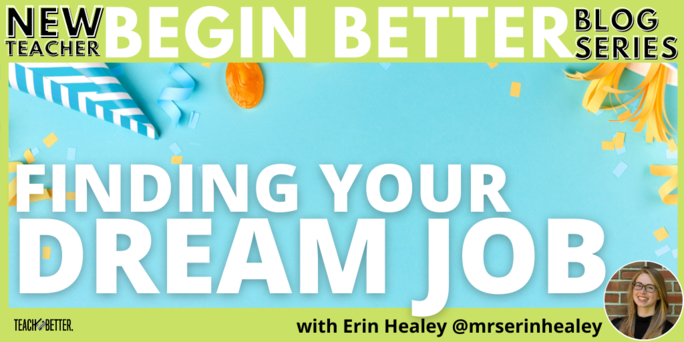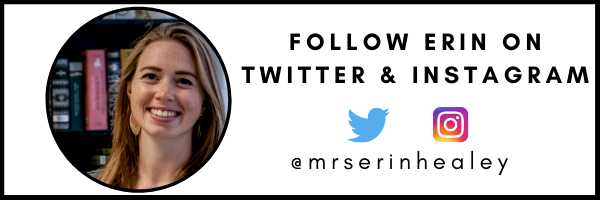TL;DR:
- To find your dream job, you first must reflect on your why. Then, make sure the responsibilities and tasks that create your job description allow you to work towards your goals and motivations.
- Land your dream job by completing background research, visualizing your position, and follow the outlined steps for an impactful interview.
In this penultimate post for our New Teacher Series, I want to talk about your “dream job.”
Whether you are about to graduate from your teacher prep program, are currently subbing, or are just seeking a change, this post is for you. Even if you think you are already in your dream job, I encourage you to keep reading! We’ll be combining a lot of the topics covered so far this year to create your personal definition of a dream job, and sharing three tips you can use in this upcoming job application season to find the best position for you.
Whether you are about to graduate from your teacher prep program, are currently subbing, or are just seeking a change, this post is for you. Click To TweetWhat is your dream job?
So many times over this series, I’ve asked you to identify your why. Why are you an educator? What drives you out of bed at the crack of dawn and gets that smile on your face as your students file into the classroom? (No, coffee is not the only answer!)
Once you’ve identified your why, you need to make sure the various responsibilities and tasks that create your job description allow you to work towards your goals and motivations. If you are not working towards your why in some capacity every single day, you are most likely not going to stay in this career for long. You have all these dreams and big ideas; you can’t forget them, no matter how hard it will seem in the moment.
Teaching is a challenge, and it is important to feel fulfilled in your position to ensure you stay at your best for your students.
You cannot pour from an empty cup. How are you filling yours? What strategies are you utilizing to ensure it stays full every day?
It is also important to feel supported in your daily quest to fulfill your why. Ask yourself how your colleagues, administrators, district, and community, are playing a role in your mission. Is your community a positive and supportive factor, or are they creating a challenge for you to truly reach your professional potential?
If you are applying to a new school, this is important to research in advance; not all administrators, curriculums, or parents are going to have the same moral, religious, political, social, or informational frameworks that you are accustomed to in your personal background or educational journey. Is this something you can work with or learn from? Or will it keep you from working towards your why?
I know it is a clichéd phrase, but teachers are not in this profession for the money. We become teachers because we have a passion, and in order to be the best teachers possible, we need to find ways to work towards that passion every single day. As you identify a position that could be your dream job, make sure you identify avenues of support and fulfillment in this mission right from the start!
Land your dream job!
Now that you’ve pictured this ideal educational position, let’s get after it! These tips will help your application stand out, and ensure you are the best candidate for your dream job.
Step 1: Do Background Research
You’ve used SchoolSpring, or your state’s equivalent job-search platform for educators, and found a fantastic position. You meet the qualifications, but want to make sure it is the job for you. Whether you are familiar with the school or district or not, you should complete two Google News searches, one Twitter search-and-follow, and a brief perusal of the district’s school committee notes.
The first Google News search should be for both the individual school, as well as the district. Checking out local news stories will give you a good idea of how involved the school is in their community, as well as what kind of reputation they have in their area. The second Google News search should be completed the day of your interview, to ensure your information is current!
When you complete the Twitter search-and-follow, look for district-level (superintendent or school-wide), administration-level (principal, athletic director, etc.), and school-level (potential future colleagues!) accounts.
Follow any accounts of individuals who may be on your interview committee, as well as other relevant accounts that get you excited about the district. Next time you go on Twitter, as you are drafting your cover letter and supplemental materials, you’ll be able to see what is going on in the school and discuss those current events or initiatives in your application!
I would highly recommend scanning the agendas or notes from a recent school committee meeting (or two). This will also be a great place to get insight into the goings-on in this district and learn more information about the community you hope to serve.
Because of COVID-19, most school committee meetings have been held on Zoom and made their meeting recordings available to the public. Maybe check one out (on 2x speed, which I’ve found helpful) to glean information to support your application or at least your understanding of a district.
Use your new knowledge to personalize your cover letter, and drive your interview content. The more you can relate to the school or community, the easier it will be for your future employer to see you fitting into their district!
Step 2: Visualize the Position
Once you’ve completed your background research, it’s time to target your cover letter and resume to this dream job application. You may have a template of an adaptable cover letter handy. If you do, I certainly hope it is not posted anywhere on your SchoolSpring account, LinkedIn page, or any other application portal!
If a potential employer sees that you have a cookie-cutter letter, they will think you are not serious about working for their school. Start fresh, or adapt your cover letter to the specific school and position by using a word cloud to get a more complete picture of what or whom this application is seeking.
I love word clouds because they automatically pull out repeated words or phrases for you and enlarge them in an easy-to-read visualization. Copy and paste the application details into your favorite word cloud generator (I like WordItOut). The largest words or phrases are the ideas your future employer cares the most about when seeking a new educator. They may not directly say they are looking for a candidate with strong tech skills, but they may mention ‘technology’ six times in their description of the position. You’ll see that in the word cloud!
Take the largest (most important) ideas and ensure the same terminology is used in both your cover letter and resume, and comes up during your interview. Your use of the same words and phrases used in the job description will draw clear connections for your future employer between your application and their ideas for a candidate.
[scroll down to keep reading]Step 3: Set Yourself Up for an Impactful Interview
Your personalized and targeted cover letter thoroughly impressed the administrators, and you’ve landed an interview! Congratulations! You have done so much background work to set yourself apart as you apply for this dream job, and you are most likely pretty nervous in the interview. The best way I know to make sure your first impression makes a positive impact is to “fake it until you make it.” Here’s how:
Appear confident and professional.
Smiling through your nerves and taking purposefully slow and deep breaths will trick your body into calming down. Your body language, whether you are in-person or interviewing via Zoom, will show your future employer how you engage in circumstances out of your comfort zone.
Never fill the silence with sounds, use only words.
This means no fillers, like umm or uhhh. I had a fantastic teacher in high school that drilled this into us as we prepared for a state civics competition. If you are stuck and need time to craft your best possible answer, just remain silent! Your silence will imply that you are thoughtfully considering your answer, rather than totally lost. You may be drawing a blank, but there’s no need to let anyone else know that!
Finally, and this is especially important for younger teachers, dress for the job you want, rather than the job you are applying for.
My general rule of thumb is to look for people around five to eight years older than me, in a job that I want, and copy their outfit. This is usually more relevant for anyone applying to a high school, where the general population may be 3-4 years younger than you; your future employer doesn’t want to possibly mistake you for a student, so imply that you act more mature by dressing the part.
I hope that you are able to use these tips to land your dream job, whatever that looks like to you! To get even more tips and tricks for your applications, please feel free to check out our Young Educators Society webinar for job-seeking educators. Best of luck and skill!
About Erin Healey
Erin is an English teacher at Chariho High School, in Rhode Island. She is the founder of the Young Educators Society of Rhode Island (@yesriorg), a Highlander Institute Fuse Fellow, current Master’s student studying Education Technology at the University of Connecticut, and can always be found drinking coffee (preferably a PSL)!




